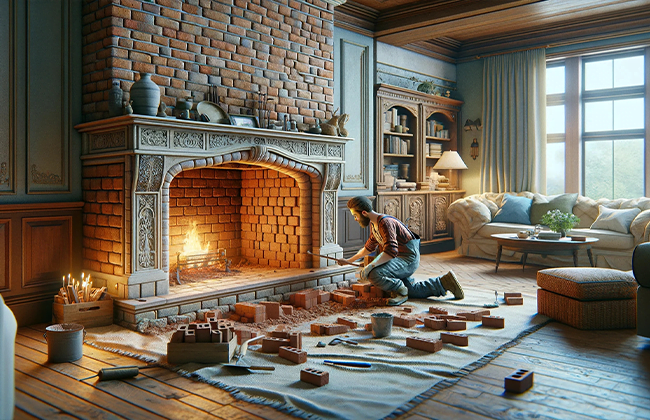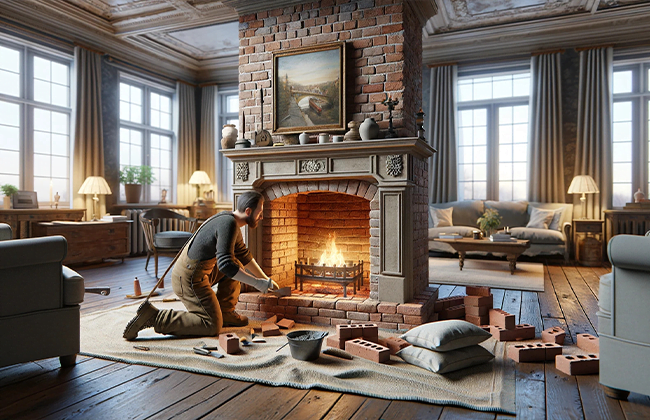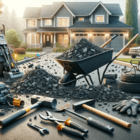Fireplace brick repair is an essential aspect of maintaining the safety and aesthetic appeal of your fireplace. Over time, the bricks and mortar of a fireplace are subjected to high temperatures, moisture, and physical wear, leading to various forms of damage. Understanding the causes, identifying early signs of wear, and knowing how to repair and maintain these bricks are crucial for any homeowner. This article delves into the intricacies of fireplace brick repair, offering a comprehensive guide that covers everything from preparation to the finishing touches, ensuring your fireplace remains a cozy and safe focal point in your home.
Table of Contents
Understanding Fireplace Brick Damage
This section emphasizes the importance of regularly inspecting fireplace bricks to identify early signs of damage, such as cracks and moisture effects. It also explains common causes of brick damage in fireplaces, including high temperatures, moisture infiltration, physical impacts, and the natural aging process.
The Importance of Regular Inspection
Regular inspection is vital in maintaining the integrity of your fireplace bricks. Over time, these bricks are exposed to extreme conditions that can lead to various forms of deterioration. By conducting routine checks, you can catch early signs of damage, such as small cracks or discoloration, before they develop into more significant problems. This proactive approach not only ensures the safety and functionality of your fireplace but also helps in avoiding costly repairs down the line.
Common Causes of Brick Damage
Brick damage in fireplaces can be attributed to several factors:
- High Temperatures: Continuous exposure to high heat can cause bricks to crack and mortar to weaken.
- Moisture Infiltration: Water or moisture penetration, often due to poor drainage or flashing issues, can lead to brick spalling (surface flaking) and mortar deterioration.
- Physical Impact: Accidental impacts from heavy objects can cause visible cracks or structural damage to bricks.
- Age-Related Wear and Tear: Over time, the natural aging process can lead to a breakdown in the material integrity of bricks and mortar.
Preparing for Fireplace Brick Repair
This part lists essential tools and materials needed for brick repair, like mortar, trowels, and safety gear. It highlights safety considerations, stressing the importance of wearing protective equipment and ensuring the fireplace is cool and clean before starting any repair work.
Gathering Necessary Tools and Materials
Before starting the repair process, gather all necessary tools and materials. This preparation ensures the process is smooth and efficient. Essential items include:
- Mortar Mix: Specific for high-temperature applications.
- Trowel: For applying and shaping mortar.
- Chisel and Hammer: To remove damaged bricks and old mortar.
- Wire Brush: To clean the brick surface.
- Safety Equipment: Gloves, goggles, and a dust mask for personal protection.
- Measuring Tools: For accurate mortar mixing and brick placement.
- Sponge and Bucket: For cleaning and finishing touches.
Safety Considerations
Safety is paramount when dealing with fireplace repairs. Ensure the fireplace is completely cool before starting any repair work. Wear protective gear such as gloves, safety goggles, and a dust mask to prevent injuries and inhalation of dust and debris. Also, ensure the work area is well-ventilated, especially when dealing with mortar and chemical sealants.
Step-by-Step Guide to Repairing Fireplace Bricks

This section provides a detailed guide on assessing the extent of damage to the fireplace bricks, safely removing damaged bricks and old mortar, applying new mortar, and correctly placing new or undamaged bricks. It also covers the curing process of mortar and finishing touches for a professional look.
Assessing the Damage
Carefully examine the fireplace to assess the extent of the damage. Look for loose or missing bricks, cracks in the mortar, and any signs of deeper structural issues. This assessment will help in determining the scope of the repair work required.
Removing Damaged Bricks and Mortar
Use a chisel and hammer to gently remove damaged bricks and mortar. Be careful not to damage surrounding bricks. Once removed, use a wire brush to clean out the cavity, removing all debris and dust.
Applying New Mortar and Replacing Bricks
Mix the mortar according to the manufacturer’s instructions. Apply a generous amount of mortar to the cavity and on the sides of the replacement brick. Carefully place the brick in position, ensuring it aligns with the existing bricks. Remove any excess mortar with a trowel and smooth the joints for a consistent look.
Curing and Finishing Touches
Allow the mortar to cure as per the specified time, usually 24-48 hours. Avoid using the fireplace during this period. Once cured, clean the repaired area with a damp sponge to remove any mortar residue, giving a neat and finished appearance.
Preventative Measures and Maintenance
In this section, tips are provided for regularly cleaning and inspecting the fireplace to prevent future damage. It also discusses applying sealants and other protective measures to safeguard bricks and mortar against damage.
Regular Cleaning and Inspection
Regularly clean the fireplace to prevent ash and soot buildup, which can contribute to brick deterioration. Inspect the bricks and mortar for any signs of damage or wear and address them promptly.
Applying Sealants and Other Protective Measures
Consider applying a sealant specifically designed for fireplaces to protect the bricks and mortar from moisture and heat damage. This can significantly extend the life of your fireplace.
Troubleshooting Common Fireplace Brick Repair Issues
This part offers strategies for addressing persistent moisture problems that can cause ongoing damage to fireplace bricks. It also provides guidance on identifying and dealing with structural issues that might affect the fireplace and its surroundings.
Addressing Persistent Moisture Problems
Moisture is a common enemy of fireplace bricks. Identify the source of moisture (such as leaks or condensation) and address it. Ensure proper ventilation and, if necessary, install a new damp-proof course or apply waterproofing measures.
Dealing with Structural Issues
If you notice significant structural issues, such as major cracks or leaning of the chimney, it’s essential to consult a professional. These issues may indicate deeper problems that require specialized attention.
Conclusion:
In conclusion, mastering the skill of fireplace brick repair is invaluable for maintaining the longevity and safety of your fireplace. Regular inspections, timely repairs, and appropriate preventative measures can significantly extend the life of your fireplace bricks, saving both time and money in the long run. This guide has walked you through each step, from understanding damage to applying the finishing touches, aiming to equip you with the knowledge needed for effective fireplace brick repair. Remember, a well-maintained fireplace not only enhances the comfort of your home but also ensures the safety of your loved ones.
FAQs:
Q: How often should I inspect my fireplace for brick repair needs?
A: Inspecting your fireplace annually is recommended. Regular checks help identify early signs of damage, such as cracks or mortar deterioration, ensuring timely fireplace brick repair.
Q: What are the signs that indicate the need for fireplace brick repair?
A: Signs include visible cracks in bricks, crumbling or loose mortar, discoloration, and evidence of moisture damage. If you notice these, it’s time for fireplace brick repair.
Q: Can I do fireplace brick repair myself, or should I hire a professional?
A: Minor repairs can be a DIY project if you’re comfortable with it. However, for extensive damage or structural issues, it’s advisable to hire a professional for fireplace brick repair.
Q: What materials are best for fireplace brick repair?
A: High-temperature-resistant mortar is ideal for fireplace brick repair. Ensure it’s specifically designed for fireplaces to withstand the heat and prevent future damage.
Q: How long does it take for the mortar to cure in fireplace brick repair?
A: The curing time for mortar typically ranges from 24-48 hours. Avoid using the fireplace during this period to ensure effective fireplace brick repair.




